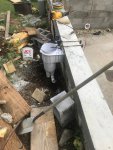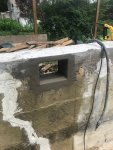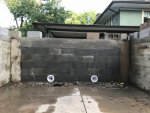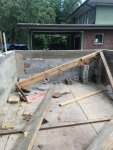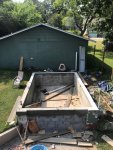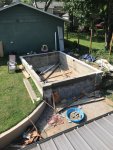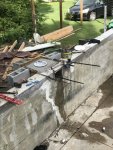Hi all,
I have this dream to turn my old semi-below grade garage footer structure into a pool. I had to tear the structure down for insurance purposes and then my wife got the idea to turn it into a pool. I am getting pretty serious into the design phase and ready to get started on it. I just got my city permit today.
The structure is about 12'x18' and 48-54" tall (sloped toward front). The three walls are made of 9-10" poured concrete. The wall where the garage door was will be filled with CMU block anchored to the existing concrete and slab with 1/2" rebar then poured full of concrete. I have spoken with a structural engineer so I believe I have that part of this project figured out but really need some help with the best way to waterproof this type of pool. Internet research has not really helped as this is a unique type of project.
I've had a few thoughts and wonder what you think:
1. Fiberglass cloth and resin epoxy. This would allow the concrete structure to move/crack a little while the fiberglass "shell" stayed intact. I don't expect movement but there are a few existing cracks in the over 100 year old walls.
2. Surface bonding concrete over the whole surface. This would fill in all the cracks and then I could come over with another layer of ?? waterproofing.
I am planning on performing most of the work myself. I have renovated this 1915 house down to the studs and am a fairly capable craftsman so it would be great if recommendations were geared toward diy type applications.
I have attached a few photos and design sketches. Any help would be more than appreciated and I am excited to get started and become a part of this community.
Feel free to tell me I am crazy but help me dream if it is possible!
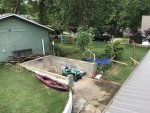

I have this dream to turn my old semi-below grade garage footer structure into a pool. I had to tear the structure down for insurance purposes and then my wife got the idea to turn it into a pool. I am getting pretty serious into the design phase and ready to get started on it. I just got my city permit today.
The structure is about 12'x18' and 48-54" tall (sloped toward front). The three walls are made of 9-10" poured concrete. The wall where the garage door was will be filled with CMU block anchored to the existing concrete and slab with 1/2" rebar then poured full of concrete. I have spoken with a structural engineer so I believe I have that part of this project figured out but really need some help with the best way to waterproof this type of pool. Internet research has not really helped as this is a unique type of project.
I've had a few thoughts and wonder what you think:
1. Fiberglass cloth and resin epoxy. This would allow the concrete structure to move/crack a little while the fiberglass "shell" stayed intact. I don't expect movement but there are a few existing cracks in the over 100 year old walls.
2. Surface bonding concrete over the whole surface. This would fill in all the cracks and then I could come over with another layer of ?? waterproofing.
I am planning on performing most of the work myself. I have renovated this 1915 house down to the studs and am a fairly capable craftsman so it would be great if recommendations were geared toward diy type applications.
I have attached a few photos and design sketches. Any help would be more than appreciated and I am excited to get started and become a part of this community.
Feel free to tell me I am crazy but help me dream if it is possible!




